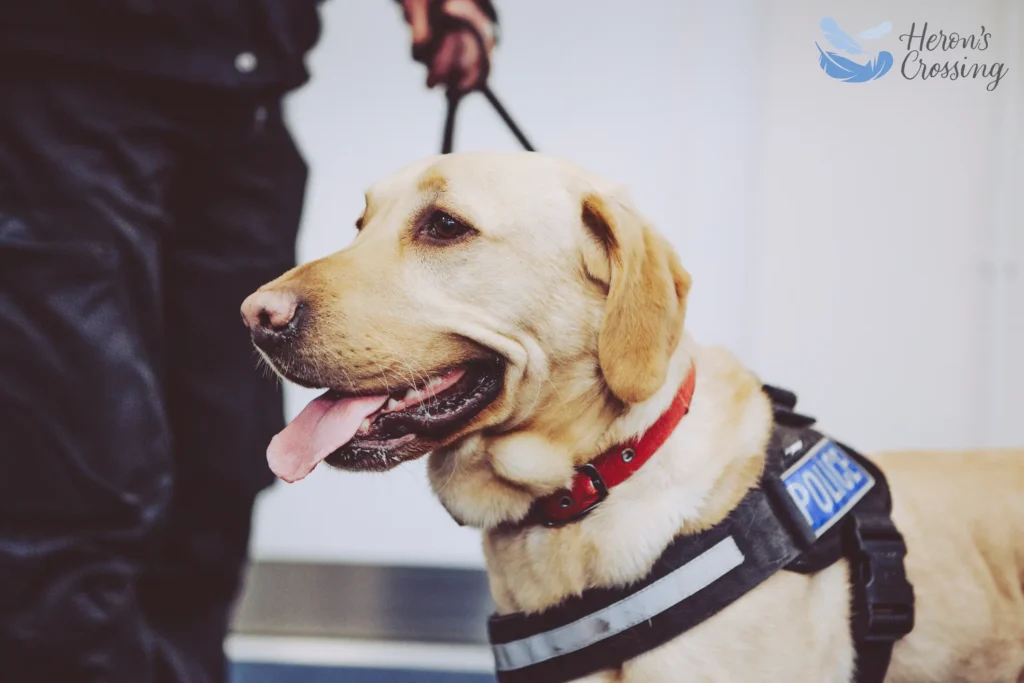Governmental agency dogs are specially bred and highly skilled. Sometimes puppies are unable to complete training. Others, at the end of a fine career, are retired due to disability or age. But then where do they go? Are they ‘too trained’ – too reactive – to be adopted by average people?
There are certain breeds that take better to the intense drilling and special missions of each agency. Police often prefer German Shepherds for their intelligence and obedience. They are used for tracking people, weapons or contraband, for patrol, and for apprehending suspects. Other dogs sometimes used are Belgian Malinois, Labrador Retrievers, Boxers, Bloodhounds, Pointers and Doberman Pinschers.
Police dogs usually come from highly reputable and contracted breeders. ‘Green’ dogs are 1 to 3 years old, and have gone through the breeder’s evaluation for intelligence, drive and courage before being recommended for duty. Then the dog and its new handler go through several months of learning at an academy before joining the K-9 corps.
Although technically government property, the dog usually stays with the same handler throughout his years of service. Sometimes the dogs have special kennels, but more often, they live with their handler.
Are only male dogs recruited? Usually. But female dogs are sometimes used on patrol.
Larger fire departments will have dogs to check for accelerants or to search buildings. The Federal Emergency Management Agency (FEMA) also has its own special canine search and rescue teams for disasters. These dogs are chosen for a heightened sense of smell, and are trained not to be distracted by fire, heat, noise and danger.
In the US military, there are approximately 2,300 working dogs on active duty at any given time. The US Department of Defense (DOD) prefers to work only with Belgian Malinois, also known as Belgian Shepherds, who are similar to German Shepherds, but are more compact, very fast and agile, loyal, and have a strong training and work ethic.
These hardy dogs seem to have no fear, even joining US Navy SEALS on helicopters, and tandem parachuting with their handlers. German Shepherds, Labrador Retrievers and German Pointers are sometimes used for less strenuous duties.
At military bases around the world, the DOD gets their ‘war dogs’ from well-established breeders in the area. Those dogs often are then adopted in place within those countries after retirement.
In the United States, the military has their own Puppy Program breeding and training facility at Lackland Air Force Base in San Antonio, TX.
Sometimes the young dogs in training turn out not to be a good fit. Perhaps the dog gets seasick, so he’s not going to make it as a SEAL. Then he usually goes back to the breeder to be placed into a different program.
In military service, the dog and handler are essentially inseparable, but at the end of the day, the dog goes to state-of-the-art kennels where he or she is given a special diet and excellent veterinary care.
You’ll find that the men and women who work side by side with these dogs are fiercely loyal to their canine counterparts. They give their dogs medals for bravery, military salutes and funerals, and plaques of honor in places such as the Military Working Dogs Heritage Museum in Newport, TN and the US War Dogs Heritage Museum in Burlington NJ.
Dogs are often retired after a traumatic event, or for disability or old age. They are referred to in the military as K9 Heroes. Sometimes if an older dog still has a lot of pep, he’ll go to the academies to help train new recruits. Those who are trained to attack are not adoptable, so they must be given other purposes within the system.
Military dogs used to be considered by the government as surplus equipment, to be left behind after a war, or euthanized after they had served their purpose. But since 2000 ‘Robby’s Law’ requires all military dogs who are suitable to be put up for adoption instead.
This Congressional Military Dog Adoption Law gives first priority to civilian law enforcement agencies, and then to handlers and their team. Since older and disabled dogs are often unfit for any more duty, the handler or a team member gets to keep him about 90 percent of the time.
About 300-400 dogs are adopted out each year. Those who are not adopted by handlers are then available to civilians, who go through a stringent adoption process. They cannot go to homes with young children.
The law also states that if a dog is adopted by a civilian, he can’t be used for any kind of guard duty, patrol, security or protection work. He finally gets to relax and be a pet.
You can apply for a retired military dog online with the DOD Military Working Dog Adoption Program at San Antonio. There is no charge to adopt, but there is a long wait as your adoption request is carefully reviewed. So be patient and be ready to go to Texas on short notice. If you miss the interview, you’ll have to apply again.
It takes a very special person to adopt such highly intelligent, highly trained animals, who will need much more interaction than a regular house pet. To adopt a retired police dog, contact your local police or fire department, or an agency like Mission K9 or Patriot K9 Rescue.
Heron’s Crossing provides end-of-life care for pets in the Metro Atlanta area. In-home appointments with compassionate vets are available. If you’d prefer a home-like setting away from your home, our Decatur office is also available by appointment.

